Sternohyoid muscle
The sternohyoid muscle is a bilaterally paired,[1] long,[1] thin,[1][2] narrow strap muscle[2] of the anterior neck.[1] It is one of the infrahyoid muscles. It is innervated by the ansa cervicalis. It acts to depress the hyoid bone.
| Sternohyoid muscle | |
|---|---|
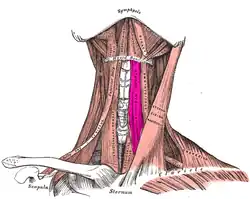 Muscles of neck. Sternohyoideus labeled at middle, just to the right of thyroid cartilage. | |
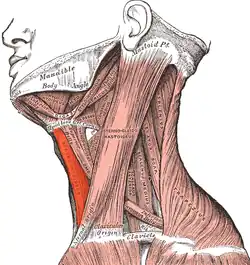 Muscles of the neck. Lateral view. Sternohyoid muscle labeled | |
| Details | |
| Origin | manubrium of sternum |
| Insertion | hyoid bone |
| Artery | superior thyroid artery |
| Nerve | C1-C3 by a branch of ansa cervicalis |
| Actions | depresses hyoid |
| Identifiers | |
| Latin | musculus sternohyoideus |
| TA98 | A04.2.04.002 |
| TA2 | 2168 |
| FMA | 13341 |
| Anatomical terms of muscle | |
Structure
The sternohyoid muscle is one of the paired strap muscles of the infrahyoid muscles.[3]
The muscle is directed superomedially from its origin to its insertion. The two muscles are separated by a considerable interval inferiorly, but usually converge by their mid-point and remain proximal until their superior insertion.[2]
Origin
It arises from the posterior aspect of the medial end (sternal extremity of the clavicle, the posterior sternoclavicular ligament, and (the superoposterior portion of) the manubrium of sternum.[2]
It inserts onto the inferior border of the body of hyoid bone.[2]
Nerve supply
The sternohyoid muscle receives motor innervation from branches of the ansa cervicalis (which are ultimately derived from cervical spinal nerves C1-C3).[2]
Variations
The muscle may be absent, doubled, exhibit a clavicular slip (the cleidohyoideus), or interrupted by a tendinous intersection;[2] it sometimes presents a transverse tendinous inscription just distal to its origin.
Actions/movements
The muscle depresses the hyoid bone when the bone is in an elevated position.[2]
Function
The sternohyoid muscle performs a number of functions:
Additional images
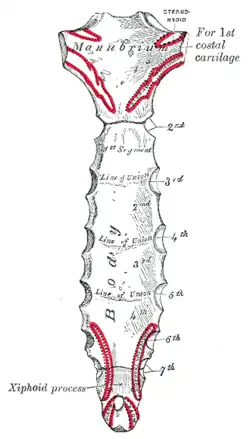 Posterior surface of sternum.
Posterior surface of sternum. Left clavicle. Inferior surface.
Left clavicle. Inferior surface.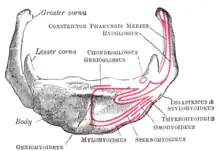 Hyoid bone. Anterior surface. Enlarged.
Hyoid bone. Anterior surface. Enlarged. Section of the neck at about the level of the sixth cervical vertebra.
Section of the neck at about the level of the sixth cervical vertebra.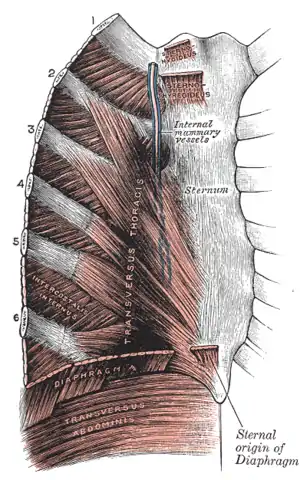 Posterior surface of sternum and costal cartilages, showing Transversus thoracis.
Posterior surface of sternum and costal cartilages, showing Transversus thoracis. The fascia and middle thyroid veins. The veins here designated the inferior thyroid are called by Kocher the thyroidea ima.
The fascia and middle thyroid veins. The veins here designated the inferior thyroid are called by Kocher the thyroidea ima..JPG.webp) Sternohyoid muscle
Sternohyoid muscle Sternohyoid muscle
Sternohyoid muscle Sternohyoid muscle
Sternohyoid muscle Sternohyoid muscle - lateral view
Sternohyoid muscle - lateral view Sternohyoid muscle - right view
Sternohyoid muscle - right view Sternohyoid muscle
Sternohyoid muscle Muscles, nerves and arteries of neck.Deep dissection. Anterior view.
Muscles, nerves and arteries of neck.Deep dissection. Anterior view.
References
![]() This article incorporates text in the public domain from page 393 of the 20th edition of Gray's Anatomy (1918)
This article incorporates text in the public domain from page 393 of the 20th edition of Gray's Anatomy (1918)
- Kim, Jong Seung; Hong, Ki Hwan; Hong, Yong Tae; Han, Baek Hwa (2015-03-01). "Sternohyoid muscle syndrome". American Journal of Otolaryngology. 36 (2): 190–194. doi:10.1016/j.amjoto.2014.10.028. ISSN 0196-0709. PMID 25484367.
- Standring, Susan (2020). Gray's Anatomy: The Anatomical Basis of Clinical Practice (42th ed.). New York. p. 581. ISBN 978-0-7020-7707-4. OCLC 1201341621.
{{cite book}}: CS1 maint: location missing publisher (link) - Chokroverty, Sudhansu (2009-01-01), Chokroverty, Sudhansu (ed.), "Chapter 7 - Physiologic Changes in Sleep", Sleep Disorders Medicine (Third Edition), Philadelphia: W.B. Saunders, pp. 80–104, doi:10.1016/b978-0-7506-7584-0.00007-0, ISBN 978-0-7506-7584-0, retrieved 2020-11-25
- Kim, Jong Seung; Hong, Ki Hwan; Hong, Yong Tae; Han, Baek Hwa (2015-03-01). "Sternohyoid muscle syndrome". American Journal of Otolaryngology. 36 (2): 190–194. doi:10.1016/j.amjoto.2014.10.028. ISSN 0196-0709. PMID 25484367.
- Hirano, M.; Koike, Y.; Leden, H. von (1967-01-01). "The Sternohyoid Muscle During Phonation: Electromyographic Studies". Acta Oto-Laryngologica. 64 (1–6): 500–507. doi:10.3109/00016486709139135. ISSN 0001-6489. PMID 6083377.
External links
- Anatomy photo:25:10-0103 at the SUNY Downstate Medical Center - "Nerves and Vessels of the Carotid triangle"
- PTCentral